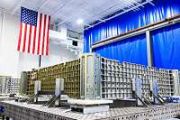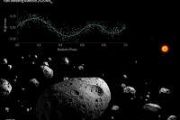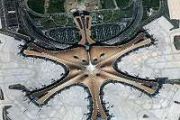
Copernical Team
Puffy young exoplanets reveal origin of super Earths
 Astronomers have identified a young planetary system that links newborn giant worlds to the compact super Earths and sub Neptunes that dominate the Milky Way. V1298 Tau, a star about 20 million years old, hosts four planets between the sizes of Neptune and Jupiter in close-in orbits, offering a snapshot of planets during a brief and dynamic stage of evolution.
Over ten years, researchers c
Astronomers have identified a young planetary system that links newborn giant worlds to the compact super Earths and sub Neptunes that dominate the Milky Way. V1298 Tau, a star about 20 million years old, hosts four planets between the sizes of Neptune and Jupiter in close-in orbits, offering a snapshot of planets during a brief and dynamic stage of evolution.
Over ten years, researchers c We finally know how the most common types of planets are created
 Thanks to the discovery of thousands of exoplanets to date, we know that planets bigger than Earth but smaller than Neptune orbit most stars. Oddly, our sun lacks such a planet. That's been a source of frustration for planetary scientists, who can't study them in as much detail as they'd like, leaving one big question: How did these planets form?
h3>Now we know the answer /h3>
An interna
Thanks to the discovery of thousands of exoplanets to date, we know that planets bigger than Earth but smaller than Neptune orbit most stars. Oddly, our sun lacks such a planet. That's been a source of frustration for planetary scientists, who can't study them in as much detail as they'd like, leaving one big question: How did these planets form?
h3>Now we know the answer /h3>
An interna M dwarf plasma torus offers window into space weather and planetary habitability
 Carnegie researcher Luke Bouma is using a naturally occurring plasma structure around certain young M dwarf stars as a kind of space weather station to investigate how stellar particles shape planetary environments and potential habitability. M dwarfs are smaller, cooler and dimmer than the Sun and commonly host at least one Earth-sized rocky planet, many of which are either too hot for liquid w
Carnegie researcher Luke Bouma is using a naturally occurring plasma structure around certain young M dwarf stars as a kind of space weather station to investigate how stellar particles shape planetary environments and potential habitability. M dwarfs are smaller, cooler and dimmer than the Sun and commonly host at least one Earth-sized rocky planet, many of which are either too hot for liquid w NSF-DOE Vera C. Rubin Observatory spots record-breaking asteroid in pre-survey observations
 As part of the NSF-DOE Vera C. Rubin Observatory First Look event in June 2025, Rubin announced that it had observed thousands of asteroids cruising about our Solar System, about 1900 of which have been confirmed as never-before-seen. Within the flurry, a team of astronomers has discovered 19 super- and ultra-fast-rotating asteroids. One of these is the fastest-spinning asteroid larger than 500
As part of the NSF-DOE Vera C. Rubin Observatory First Look event in June 2025, Rubin announced that it had observed thousands of asteroids cruising about our Solar System, about 1900 of which have been confirmed as never-before-seen. Within the flurry, a team of astronomers has discovered 19 super- and ultra-fast-rotating asteroids. One of these is the fastest-spinning asteroid larger than 500 Sandblasting winds sculpt Mars landscape
 Martian winds lift sand grains into the air and drive them across the surface, where they erode soft sedimentary layers and gradually carve elongated grooves and ridges near the planet's equator. The remaining ridges, mounds, or columns, known as yardangs, stand above the surrounding terrain and often extend for tens of kilometres in the direction of the prevailing winds.
In northern Eumen
Martian winds lift sand grains into the air and drive them across the surface, where they erode soft sedimentary layers and gradually carve elongated grooves and ridges near the planet's equator. The remaining ridges, mounds, or columns, known as yardangs, stand above the surrounding terrain and often extend for tens of kilometres in the direction of the prevailing winds.
In northern Eumen Lunar spacecraft exhaust could obscure clues to origins of life
 Over half of the exhaust methane from lunar spacecraft could end up contaminating areas of the moon that might otherwise yield clues about the origins of earthly life, according to a recent study. The pollution could unfold rapidly regardless of a spacecraft's touchdown site; even for a landing at the South Pole, methane molecules may "hop" across the lunar surface to the North Pole in under two
Over half of the exhaust methane from lunar spacecraft could end up contaminating areas of the moon that might otherwise yield clues about the origins of earthly life, according to a recent study. The pollution could unfold rapidly regardless of a spacecraft's touchdown site; even for a landing at the South Pole, methane molecules may "hop" across the lunar surface to the North Pole in under two Second ESCAPADE spacecraft completes key trajectory fix on path to Mars
 NASA's twin ESCAPADE spacecraft are back on a fully synchronized path to Mars after mission controllers successfully carried out a critical trajectory correction maneuver for the second probe on Jan. 6. The burn followed a brief pause in December 2025, when engineers delayed the attempt to investigate low thrust seen during earlier correction efforts on one of the two small satellites.
The
NASA's twin ESCAPADE spacecraft are back on a fully synchronized path to Mars after mission controllers successfully carried out a critical trajectory correction maneuver for the second probe on Jan. 6. The burn followed a brief pause in December 2025, when engineers delayed the attempt to investigate low thrust seen during earlier correction efforts on one of the two small satellites.
The The next great space race: Building data centers in orbit
Verifying that you are not a bot
Aegis Aerospace and United Semiconductors plan in orbit semiconductor materials plant
 Aegis Aerospace Inc. has entered into a partnership with United Semiconductors LLC to develop semiconductor manufacturing capabilities in low Earth orbit as part of a new advanced materials production platform. The collaboration follows a recent grant agreement between Aegis Aerospace and the Texas Space Commission to design and operate an in-space manufacturing system for advanced materials in
Aegis Aerospace Inc. has entered into a partnership with United Semiconductors LLC to develop semiconductor manufacturing capabilities in low Earth orbit as part of a new advanced materials production platform. The collaboration follows a recent grant agreement between Aegis Aerospace and the Texas Space Commission to design and operate an in-space manufacturing system for advanced materials in K dwarf survey maps stellar neighborhood for habitable worlds
 A Georgia State University astronomy graduate student has led a new survey of nearby K-type stars to identify targets where Earth-like planets could provide conditions suitable for life. Sebastian Carrazco-Gaxiola presented the results at the January 2026 meeting of the American Astronomical Society in Phoenix, Arizona.
The project delivers the first comprehensive spectroscopic census of t
A Georgia State University astronomy graduate student has led a new survey of nearby K-type stars to identify targets where Earth-like planets could provide conditions suitable for life. Sebastian Carrazco-Gaxiola presented the results at the January 2026 meeting of the American Astronomical Society in Phoenix, Arizona.
The project delivers the first comprehensive spectroscopic census of t 

































